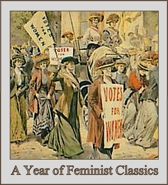Irish Short Story Week – Le Fanu
In honor of St Patrick’s Day, Mel U at The Reading Life is hosting Irish Short Story Week. Today I am reading supernatural tales by Joseph Sheridan Le Fanu.
The first story I read was “An Authentic Narrative of a Haunted House.” This short tale is presented as a matter of fact account of the happenings in a house that a family is staying at.
“All the persons—and there are many of them living—upon whose separate evidence some parts, and upon whose united testimony others, of this most singular recital depend, are, in their several walks of life, respectable, and such as would in any matter of judicial investigation be deemed wholly unexceptionable witnesses”
This factual-like presentation style is what makes this tale so haunting. It has the feel of reality to it. It is filled with very simple descriptions of apparitions and disturbances. The narrator’s nonchalant and straight forward descriptions give the story the feel that it could be an accurate account. This was a cleverly written short story that was haunting in its true to life feel.
“Dickon the Devil” is a simple almost humorous tale of a man who visits a haunted house and hears a tale about it.
“Old wives’ tales; many years ago, that will be, sir; I forget ’em; I forget ’em all. Oh yes, there always will be, when a house is left so; foolish folk will always be talkin'”
This story spends much of its time setting the scene and describing the landscape and house. When it finally gets to the action Le Fanu describes what a ghostly encounter can do to a man. It is a very simple style first person narrative short tale.
The final story I read “The Child that went with the Fairies” begins with detailed imagery of the land.
“A wide, black bog, level as a lake, skirted with copse, spreads at the left, as you journey northward, and the long and irregular line of mountain rises at the right, clothed in heath, broken with lines of grey rock that resemble the bold and irregular outlines of fortifications…”
It is an intriguing tale. Le Fanu goes into some detail of the superstitious behavior of a rural Irish widow.
“Here certainly were defences and bulwarks against the intrusion of that unearthly and evil power, of whose vicinity this solitary family were constantly reminded by the outline of Lisnavoura, that lonely hillhaunt of the ‘Good people,’ as the fairies are called euphemistically, whose strangely dome-like summit rose not half a mile away, looking like an outwork of the long line of mountain that sweeps by it.”
Then it tells a tale of her three children and their encounter with fairies. His descriptions of the fairies are different and the portrayal of them as something we need to be protected from is vastly contrary to the typical American viewpoint of fairies.
The story is both haunting and sad, though not scary like his other tales. The descriptions and imagery in this story are very detailed and well written. This so far has been my favorite of the short stories for Irish Short Story Week.










Thanks for joining in-I “discovered” Le Fanu while researching this week-you might like his longer work-100 pages, Carmilla. I liked it a lot-I sort of thought maybe “The Child That Went With the Fairies” is also an account of how the Irish dealt with the death by starvation of so many children during the bad years-I really hope this will be an annual event-